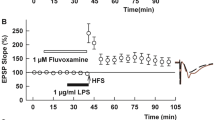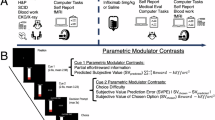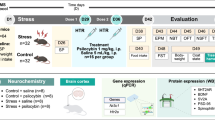Abstract
Antidepressants produce various immunomodulatory effects, as well as an attenuation of the behavioral responses to immune challenges, such as lipopolysaccharide (LPS). To explore further the effects of antidepressants on neuroimmune interactions, rats were treated daily with either fluoxetine (Prozac) or saline for 5 weeks, and various behavioral, neuroendocrine, and immune functions were measured following administration of either LPS or saline. Chronic fluoxetine treatment significantly attenuated the anorexia and body weight loss, as well as the depletion of CRH-41 from the median eminence and the elevation in serum corticosterone levels induced by LPS. Chronic treatment with imipramine also attenuated LPS-induced adrenocortical activation. In rats and in mice, which normally display a biphasic body temperature response to LPS (initial hypothermia followed by hyperthermia), chronic treatment with fluoxetine completely abolished the hypothermic response and facilitated and strengthened the hyperthermic response. The effects of antidepressants on the responsiveness to LPS are probably not mediated by their effects on peripheral proinflammatory cytokine production, because LPS-induced expression of TNFα and IL-1β mRNA in the spleen (assessed by semiquantitative in situ hybridization) was not altered following chronic treatment with either fluoxetine or imipramine. The effects of antidepressants on the acute phase response may have important clinical implications for the psychiatric and neuroendocrine disturbances that are commonly associated with various medical conditions.
Similar content being viewed by others
Log in or create a free account to read this content
Gain free access to this article, as well as selected content from this journal and more on nature.com
or
References
Alexopoulos GS . (1996): The treatment of depressed demented patients. J Clin Psychiat 57: 14–20
Altemus M, Cizza G, Gold PW . (1992): Chronic fluoxetine treatment reduces hypothalamic vasopressin secretion in vitro. Brain Res 593: 311–313
Anisman H, Merali Z . (1999): Anhedonic and anxiogenic effects of cytokine exposure. In Dantzer R, Wollman EE, Yirmiya R (eds), Cytokines, Stress, and Depression. New York, Kluwer Academic/Plenum Publishers, pp 199–233
Bianchi M, Sacerdote P, Panerai AE . (1994): Fluoxetin reduces inflammatory edema in the rat: Involvement of the pituitary–adrenal axis. Eur J Pharmacol 263: 81–84
Bianchi M, Rossoni G, Sacerdote P, Panerai AE, Berti F . (1995): Effects of clomipramine and fluoxetin on subcutaneous carragenin-induced inflammation in the rat. Inflammation Res 44: 466–469
Bluthe RM, Crestani F, Kelley KW, Dantzer R . (1992): Mechanisms of the behavioral effects of interleukin 1. Role of prostaglandins and CRF. Ann NY Acad Sci 650: 268–275
Brady LS, Whitfield HJ, Fox RJ, Gold PW, Herkenham M . (1991): Long-term antidepressant administration alters corticotropin-releasing hormone, tyrosine hydroxylase, and mineralocorticoid receptor gene expression in rat brain. Therapeutic implications. J Clin Invest 87: 831–837
Brady LS, Gold PW, Herkenham M, Lynn AB, Whitfield HJ . (1992): The antidepressants fluoxetine, idazoxan, and phenelzine alter corticotropin-releasing hormone and tyrosine hydroxylase mRNA levels in rat brain: Therapeutic implications. Brain Res 572: 117–125
Chappell PB, Smith MA, Kilts CD, Bissetta G, Ritchie J, Anderson C, Nemeroff CB . (1986): Alterations in corticotropin-releasing factor-like immunoreactivity in discrete rat brain regions after acute and chronic stress. J Neurosci 6: 2908–2914
Dantzer R, Wollman EE, Vitkovic L, Yirmiya R . (1999): Cytokines and depression: Fortuitous or causative association? Mol Psychiat 4: 328–332
De-Bellis MD, Gold PW, Geracioti TD, Listwak SJ, Kling MA . (1993): Association of fluoxetine treatment with reductions in CSF concentrations of corticotropin-releasing hormone and arginine vasopressin in patients with major depression. Am J Psychiat 150: 656–657
Derijk RH, Berkenbosch F . (1994): Hypothermia to endotoxin involves the cytokine tumor necrosis factor and the neuropeptide vasopressin in rats. Am J Physiol 255: R9–R14
Derijk RH, Van-Kampen M, Van-Rooijen N, Berkenbosch F . (1994): Hypothermia to endotoxin involves reduced thermogenesis, macrophage-dependent mechanisms, and prostaglandins. Am J Physiol 266: R1–R8
Dinarello CA, Wolff SM . (1993): The role of interleukin-1 in disease. New Engl J Med 328: 106–113
Duncan GE, Knapp DJ, Carson SW, Breese GR . (1998): Differential effect of chronic antidepressant treatment on swim stress- and fluoxetine-induced secretion of corticosterone and progesterone. J Pharmacol Exp Ther 285: 579–587
Egberts AC, Leufkens HG, Hofman A, Hoes AW . (1997): Incidence of antidepressant drug use in older adults and association with chronic diseases: The Rotterdam Study. Int Clin Psychopharmacol 12: 217–223
Evans DL, Staab J, Ward H, Leserman J, Perkins DO, Golden RN, Petito JM . (1996): Depression in the medically ill: Management considerations. Depress Anx 4: 199–208
Givalois L, Becq H, Siaud P, Ixart G, Assenmacher I, Barbanel G . (1999): Serotonergic and suprachiasmatic nucleus involvement in the corticotropic response to systemic endotoxin challenge in rats. J Neuroendocrinol 11: 629–636
Guo AL, Petraglia F, Criscuolo M, Ficarra G, Salvestroni C, Nappi RE, Trentini GP, Genazzani AR . (1996): Adrenergic and serotonergic receptors mediate the immunological activation of corticosterone secretion in male rats. Gynecol Endocrinol 10: 149–154
Heisler LK, Kanarek RB, Homoleski B . (1999): Reduction of fat and protein intakes but not carbohydrate intake following acute and chronic fluoxetine in female rats. Pharmacol Biochem Behav 63: 377–385
Johnson RW, Propes MJ, Shavit Y . (1996): Corticosterone modulates the behavioral and metabolic effects of lipopolysaccharide. Am J Physiol 270: R192–R198
Kluger MJ . (1991): Fever: Role of pyrogens and cryogens. Physiol Rev 71: 93–127
Kubera M, Symbirtsev A, Basta-Kaim A, Borycz J, Roman A, Papp M, Claesson M . (1996): Effect of chronic treatment with imipramine on interleukin-1 and interleukin-2 production by splenocytes obtained from rats subjected to chronic mild stress model of depression. Polish J Pharmacol 48: 503–506
Laghrissi-Tode F, Pollock BG, Szanto K, Reynolds CF . (1996): Depression and suicide in medically ill patients. Curr Opin Psychiat 9: 137–140
Landmann R, Schaub B, Link S, Wacker HR . (1997): Unaltered monocyte function in patients with major depression before and after three months of antidepressive therapy. Biol Psychiat 41: 675–681
Lauritzen L, Bendsen BB, Vilmar T, Bendsen EB, Lunde M, Bech P . (1994): Post-stroke depression: Combined treatment with imipramine or desipramine and mianserin. Psychopharmacology 114: 119–122
Leon LR, Kozac W, Rudolph K, Kluger MJ . (1999): An antipyretic role for interleukin-10 in LPS fever in mice. Am J Physiol 276: R81–R89
Li Q, Levy AD, Cabrera TM, Brownfield MS, Battaglia G, Van de Kar LD . (1993): Long-term fluoxetine, but not desipramine, inhibits the ACTH and oxytocin responses to the 5-HT1a agonist, 8-OH-DPAT, in male rats. Brain Res 630: 148–156
Maes M, Vandoolaeghe E, Van Hunsel F, Bril T, Demedts P, Wauters A, Neels H . (1997): Immune disturbances in treatment-resistant depression: Modulation by antidepressive treatment. Human Psychopharmacol 12: 153–162
Maes M, Song C, Lin AH, Bonaccorso S, Kenis G, De-Jongh R, Bosmans E, Scharpe S . (1999): Negative immunoregulatory effects of antidepressants: Inhibition of interferon-gamma and stimulation of interleukin-10 secretion. Neuropsychopharmacology 20: 370–379
Maier SF, Watkins LR . (1998): Cytokines for psychologists: Implications of bidirectional immune-to-brain communication for understanding behavior, mood, and cognition. Psych Rev 105: 83–107
Marti O, Gavalda A, Gomez F, Armario A . (1994): Direct evidence for chronic stress-induced facilitation of the adrenocorticotropin response to a novel acute stressor. Neuroendocrinology 60: 1–7
McGuirk J, Muscat R, Willner P . (1992): Effects of chronically administered fluoxetine and fenfluramine on food intake, body weight, and the behavioral satiety sequence. Psychopharmacology-Berl 106: 401–407
Michelson D, Misiewicz-Poltorak B, Raybourne RB, Gold PW, Sternberg EM . (1994): Imipramine reduces the local inflammatory response to carrageenin. Agents Actions 42: 25–28
Michelson D, Galliven E, Hill L, Demitrack M, Chrousos G, Gold PW . (1997): Chronic imipramine is associated with diminished hypothalamic-pituitary-adrenal axis responsivity in healthy humans. J Clin Endocrinol Metab 82: 2601–2606
Paul L, Fraifeld V, Kaplansky J . (1999): Evidence supporting involvement of leukotrienes in LPS-induced hypothermia in mice. Am J Physiol 276: R52–R58
Raap DK, Evans S, Garcia F, Li Q, Muma NA, Wolf WA, Battaglia G, Van-De-Kar LD . (1999): Daily injections of fluoxetine induce dose dependent desensitization of hypothalamic 5-HT1A receptors: reductions in neuroendocrine responses to 8-OH-DPAT and in levels of G3 and Gi proteins. J Pharmacol Exp Ther 288: 98–106
Rabkin JG, Wagner G, Rabkin R . (1994): Effects of sertaline on mood and immune status in patients with major depression and HIV illness: An open trial. J Clin Psychiat 55: 433–439
Razavi D, Allilaire JF, Smith M, Salimpour A, Verra M, Desclaux B, Saltel P, Piollet I, Gauvain-Piquard A, Trichard C, Cordier B, Fresco R, Guillibert E, Sechter D, Orth JP, Bouhassira M, Mesters P, Blin P . (1996): The effect of fluoxetine on anxiety and depression symptoms in cancer. Acta Psychiatr Scan 94: 205–210
Reul JMHM, Stec I, Soder M, Holsboer F . (1993): Chronic treatment of rats with antidepressant amitriptyline attenuates the activity of the hypothalamic-pituitary-adrenocortical system. Endocrinology 133: 312–320
Romanovsky AA, Simons CT, Szekely M, Kulchitsky VA . (1997): The vagus nerve in the thermoregulatory response to systemic inflammation. Am J Physiol 273: R407–R413
Rothwell NJ, Luheshi G, Toulmond S . (1996): Cytokines and their receptors in the central nervous system: Physiology, pharmacology, and pathology. Pharmacol Therapeu 69: 85–95
Sacoccio C, Dornand J, Barbanel G . (1998): Differential regulation of brain and plasma TNFα produced after endotoxin shock. Neuroreport 9: 309–313
Saper CB . (1998): Neurobiological basis of fever. Ann NY Acad Sci 856: 90–94
Sapolsky RM, Krey LC, McEwen BS . (1984): Glucocorticoid-sensitive hippocampal neurons are involved in terminating the adrenocortical stress response. Proc Natl Acad Sci USA 81: 6174–6177
Schiffer RB, Wineman NM . (1990): Antidepressant pharmacotherapy of depression associated with multiple sclerosis. Am J Psychiat 147: 1493–1497
Seidel A, Arolt V, Hunstiger M, Rink L, Behnisch A, Kirchner H . (1996): Major depressive disorder is associated with elevated monocyte counts. Acta Psychiat Scand 94: 198–204
Shen Y, Connor TJ, Kelly JP, Leonard BE . (1999): Differential effect of chronic antidepressant treatment on lipopolysaccharide-induced depressive-like behavioral symptoms in the rat. Life Sci 65: 1773–1786
Sluzewska A, Rybakowski J, Laciak M, Mackiewicz A, Sobieska M, Wiktorowicz K . (1995): Interleukin-6 serum levels in depressed patients before and after treatment with fluoxetine. Ann NY Acad Sci 762: 474–476
Sommer N, Loschmann PA, Northoff GH, Weller M, Steinbrecher A, Steinbach JP, Lichtenfels R, Meyermann R, Riethmuller A, Fontana A, Dichgans J, Martin R . (1995): The antidepressant rolipram suppresses cytokine production and prevents autoimmune encephalomyelitis. Nature Med 1: 244–248
Song C, Leonard BE . (1994): An acute phase protein response in the olfactory bulbectomized rat: Effect of sertraline treatment. Med Sci Res 22: 313–314
Tilders FJH, Derijk RH, Vandam AM, Vincent VAM, Schotanus K, Persoons JHA . (1994): Activation of the hypothalamus-pituitary-adrenal axis by bacterial endotoxins—Routes and intermediates. Psychoneuoendocrinology 19: 209–232
Uehara A, Sekiya C, Takasugi Y, Namiki M, Arimura A . (1989): Anorexia-induced by interleukin 1: Involvement of corticotropin-releasing factor. Am J Physiol 257: R613–R617
Wang J, Ando T, Dunn AJ . (1997): Effect of homologous interleukin-1, interleukin-6, and tumor necrosis factor-alpha on the core body temperature of mice. Neuroimmunomodulation 4: 23–236
Weidenfeld J, Yirmiya R . (1996): Effect of bacterial endotoxin on the glucocorticoid feedback regulation of adrenocortical response to stress. Neuroimmunomodulation 3: 352–357
Weizman R, Laor N, Podliszewski E, Notti I, Djaldetti M, Bessler H . (1994): Cytokine production in major depressed patients before and after clomipramine treatment. Biol Psychiat 35: 42–47
Willner P . (1997): Validity, reliability, and utility of the chronic mild stress model of depression: a 10-year review and evaluation. Psychopharmacology 134: 319–329
Xia Z, Depierre JW, Nassberger L . (1996): Tricyclic antidepressants inhibit IL-6, IL-1β and TNF-α release in human blood monocytes and IL-2 and interferon-γ in T-cells. Immunobiology 34: 27–37
Yirmiya R, Rosen H, Donchin O, Ovadia H . (1994): Behavioral effects of lipopolysaccharide in rats: Involvement of endogenous opioids. Brain Res 648: 80–86
Yirmiya R . (1996): Endotoxin produces a depressive-like syndrome in rats. Brain Res 711: 163–174
Yirmiya R . (1997): Behavioral and psychological effects of immune activation: Implications for “depression due to a general medical condition.”. Curr Opin Psychiat 10: 470–476
Yirmiya R, Barak O, Avitsur R, Gallily R, Weidenfeld J . (1997): Intracerebral administration of Mycoplsma fermentans produces sickness behavior: Role of prostaglandins. Brain Res 749: 71–81
Yirmiya R, Weidenfeld J, Pollak Y, Morag M, Morag A, Avitsur R, Barak O, Reichenberg A, Cohen E, Shavit Y, Ovadia H . (1999): Cytokines, “depression due to a general medical condition” and antidepressants drugs. In Dantzer R, Wollman EE, Yirmiya R (eds), Cytokines, Stress, and Depression. New York, Kluwer Academic/Plenum Publishers, pp 283–316
Zhang Y, Raap DK, Garcia F, Serres F, Ma Q, Battaglia G, Van de Kar LD . (2000): Long-term fluoxetine produces behavioral anxiolytic effects without inhibiting neuroendocrine responses to conditioned stress in rats. Brain Res 855: 58–66
Zhu J, Bengtsson BO, Mix E, Thorell LH, Olsson T, Link H . (1994): Effect of monoamine reuptake inhibiting antidepressants on major histocompatibility complex expression on macrophages in normal rats and rats with experimental allergic neuritis (EAN). Immunopharmacology 27: 225–244
Acknowledgements
The authors thank Edna Cohen, Roee Canaan, Inbal Goshen, and Anna Itzik for their help in running the experiments. This work was supported by Grant 94-204 from the United-States-Israel Binational Science Foundation, by a grant from the Milton Rosenbaum Foundation for Psychiatric Research, and by the Center for Research on Pain, The Hebrew University of Jerusalem. RY is a member of the Eric Roland Center for Neurodegenerative diseases.
Author information
Authors and Affiliations
Rights and permissions
About this article
Cite this article
Yirmiya, R., Pollak, Y., Barak, O. et al. Effects of Antidepressant Drugs on the Behavioral and Physiological Responses to Lipopolysaccharide (LPS) in Rodents. Neuropsychopharmacol 24, 531–544 (2001). https://doi.org/10.1016/S0893-133X(00)00226-8
Received:
Revised:
Accepted:
Issue date:
DOI: https://doi.org/10.1016/S0893-133X(00)00226-8
Keywords
This article is cited by
-
Astrocyte reactivity and inflammation-induced depression-like behaviors are regulated by Orai1 calcium channels
Nature Communications (2023)
-
PSD-93 up-regulates the synaptic activity of corticotropin-releasing hormone neurons in the paraventricular nucleus in depression
Acta Neuropathologica (2021)
-
Systemic immunization with altered myelin basic protein peptide produces sustained antidepressant-like effects
Molecular Psychiatry (2020)
-
Microglia: A Central Player in Depression
Current Medical Science (2020)
-
Circulating endothelial cell-derived extracellular vesicles mediate the acute phase response and sickness behaviour associated with CNS inflammation
Scientific Reports (2017)



